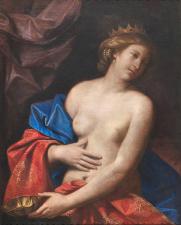Dying Nude Sophonisba
The subject
The subject is the Death of Sophonisba, a tragedy sung by, among others, Trissino and Alfieri in their literary works. The story goes that Sophonisba, the daughter of Hasdrubal, king of the Carthaginians, and wife of Syphax, king of Numidia, was forced to marry Massinissa and then sent to Scipio. But so as to avoid becoming a war trophy she proudly chose death, drinking the poison given to her by Massinissa.
Iconographically, the queen appears different than she does in the other version painted by Barbieri and preserved in this same collection: she is portrayed nude, partially wrapped in red and blue cloths and is captured in the moment just after she swallows the poison, as she carelessly sets down the empty cup, averting her gaze in either extreme aversion or a great gesture of defiance to her torturer, while her other hand rests against her stomach.
Her nude features are enhanced by the refined gestural expressiveness of her hands, highlighting the classical influence on the work, while her finely decorated clothing and hairstyle decorated with pearls heighten her regal dignity.
The painting
Although the work did not appear in Guercino’s account book, top experts in the field including Stephen Pepper and Denis Mahon (written communication on 8 October 1999), agree on the attribution to the master from Cento, suggesting that this may be the piece cited in Malvasia’s biography in his collected works on Bolognese painting, Felsina Pittrice (1678, vol. II page 367) from 1630, entitled “A Sophonisba for Panino”.
The Panini family was an important one in Cento and had already employed Guercino several times to decorate their villa between 1615 and 1617. Another factor that helped in the chronological dating of the painting was the brilliant colour of its drapery that contrasts with the sombre theatricalism of the dark curtain, almost as if the curtain were falling on the life of the young queen.
This is a true masterpiece of Baroque grandeur, the work of a powerful and solemn hand, rightly paired by Pepper with one of Guercino’s greatest masterpieces, Cleopatra giacente, preserved at the Palazzo Rosso in Genoa.







